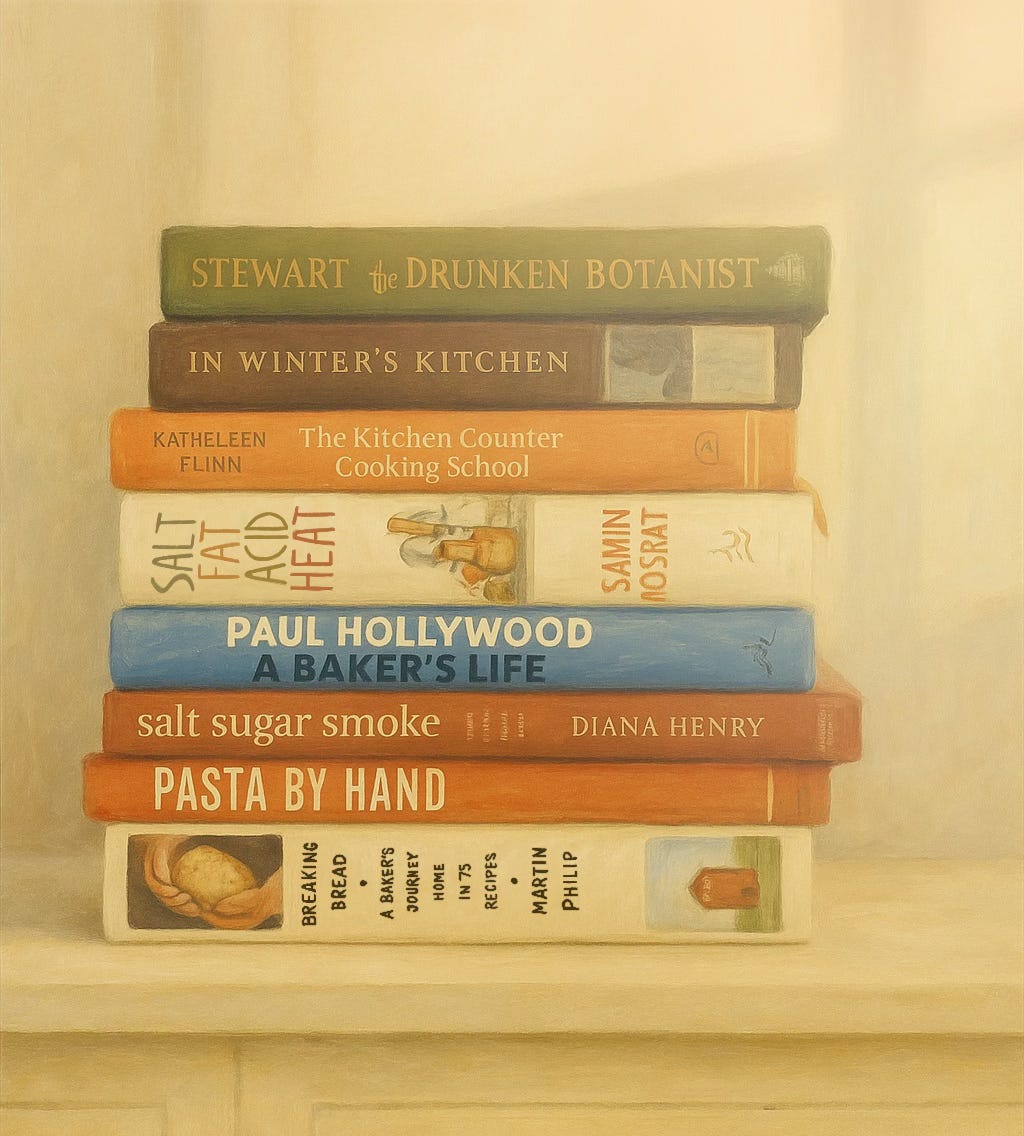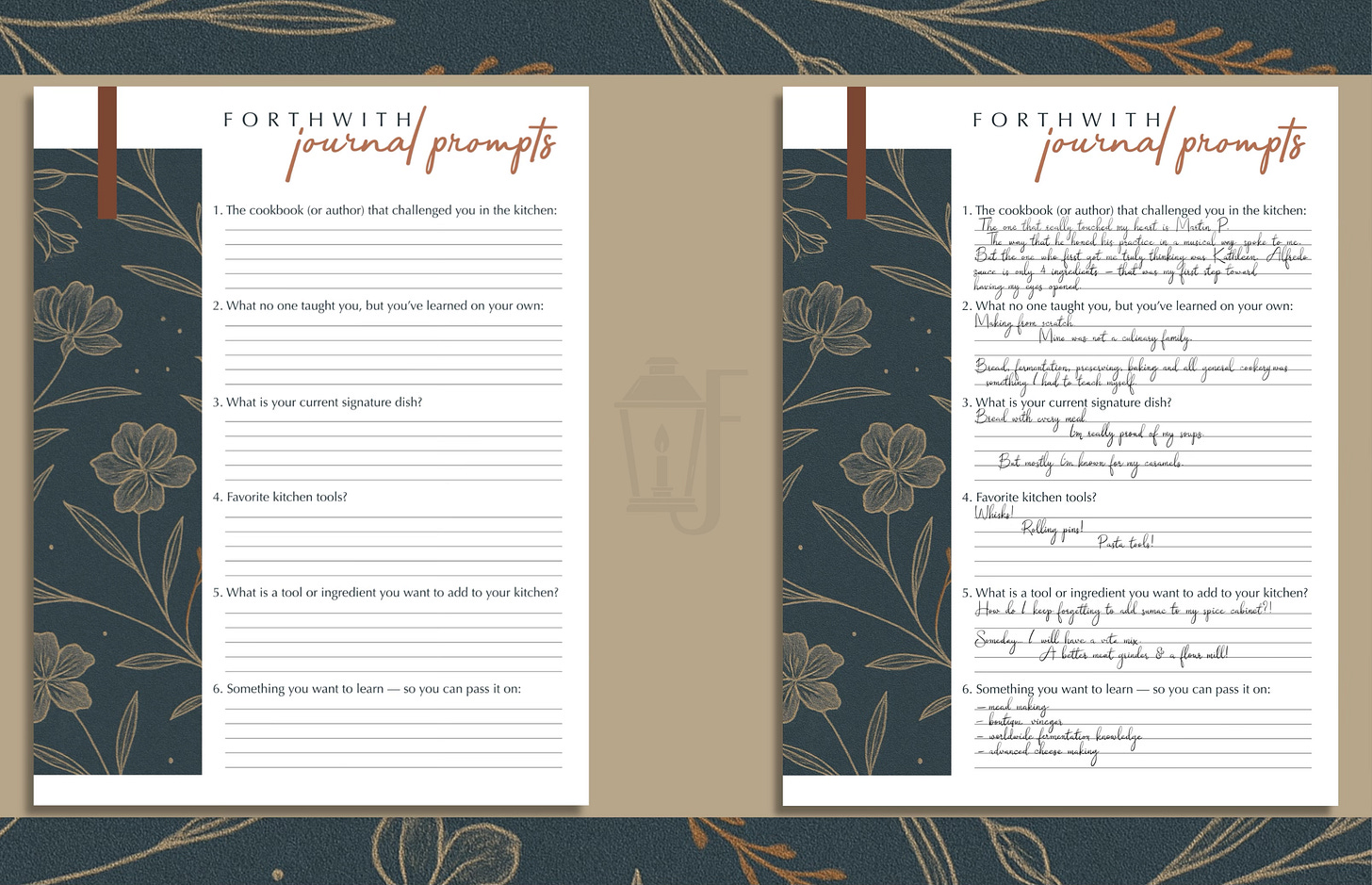Finding Freedom in the Kitchen
Cookbooks that taught me to taste & the books that taught me to trust.
These books feel like friends.
They showed me so many things I was never taught. They opened doors to new flavors, pushed me to hone my skills and gave me the courage to keep going. Most importantly, I was challenged to close the books altogether and to trust myself in the kitchen.
Through the steady guidance of these authors, I learned how to taste for myself and how to ask better questions. Some taught the history and wonder behind their techniques while the others showed me how to follow my own ideas instead leaning on a set of instructions.
It’s freedom woven with tradition.
Part One — Foundations
The Books That Taught Me
I wasn’t raised with a wealth of food knowledge. No grandmother passing down recipes. No afternoons spent beside mom at the stove. In those years, cooking was just a chore for whoever it fell to, something to be completed. No delight in the process.
I found joy later.
In books like these, I discovered wonder. The thrill of anticipation while waiting for a new bake to finish cooking. The peace that came from learning something true and grounded and good.
Most of all — I found my calling: making.
Handmade, homemade.
That’s me.
Pasta by Hand — by Jenn Louis
A Collection of Italy’s Regional Hand-Shaped Pasta
— — — — —
I found this book by accident. I was late to the game, electronically, only learning to use Instagram sometime in 2015. That is where I saw a photo of the most alluring pasta. It belonged to Jenn Louis.
Opening her book for the first time was… blissful. I read it in a single afternoon. I love a cookbook that reads like a novel.
She traveled all across Italy, collecting each subregion’s beloved hand formed pasta shapes. From the playful ciciones of Sardinia to the delicate semolina frascarelli of Lazio to the sweetly named donzelline of Tuscany.
What makes this book special isn’t just the amassing of pasta shapes, it’s the care. The deep reverence.
Jenn didn’t write this to impress. She wrote it to preserve. Through that mission, she gifted something ancient and storied into my own kitchen.
She gave my hands knowledge.
Salt Sugar Smoke — by Diana Henry
How to preserve fruit, vegetables, meat, and fish
— — — — —
It was on my first trip to New York that I found the best store ever — Kitchen Arts and Letters. A whole bookstore devoted to kitchens and letters? It felt like this little corner of the city had been created just for me.
This is where I found Salt Sugar Smoke.
From somewhere inside the overwhelming shelves and stacks, this simple book spine caught my eye and made the long flight home with me.
When I was young, food preservation meant vacuum seals, shelf stabilization (through preservatives) and flash freezing. It was about efficiency and convenience, not stewardship.
This book showed me another way — the opposite way.
Through Diana’s lens, preserving became a kind of return. A conversation between hands and seasons. This book felt familiar and inspiring all at once.
She makes “putting up” look enticing. Jams, pickles, smoked fish, bottled syrups. Nothing flashy, just grounded. Beautiful. Using what the land and seasons gave. The time given to the preserving isn’t a chore with Diana, it’s a gift from the generations before you and the seasons ahead of you.
She shows how practice becomes skill, how time becomes an ingredient and how honoring your food’s roots—and your own—changes everything.
A Baker’s Life — by Paul Hollywood
From childhood bakes to five-star excellence
— — — — —
An old friend once told me I should watch this English baking show. That’s how it started, a simple Netflix nudge. Now I own most of Paul Hollywood’s books. It was a slippery slope, but I loved every minute of it.
He’s succinct, a little gruff, and the author of one of the most beautiful baking books I’ve ever read. Now remember, I collect books, so I’ve seen a fair few.
But this one stands out. The photography. The design. The memories woven into the pages and the recipes themselves. Solid, straightforward, perfect.
Watching The Great British Baking Show ignited a bread fever in me. The cakes, tarts and biscuits are charming. But the bread?
Bread is magic.
The mixing, the waiting, the proofing, the final bake… it’s a study in breathing.
This is the book that taught me how to work with time, not against it.
Breaking Bread — by
A Baker’s Journey Home in 75 Recipes
— — — — —
I didn’t expect to find such depth in a book about bread. Yet there it was, mixed in with the flour, memory and craft. And there I was… crying at the nostalgia of a life that wasn’t mine.
This book surprised me. Martin writes about his own story with such humility and yet his recipes are direct, exacting and breathtaking.
From the Ozarks to Juilliard to the King Arthur Bakehouse in Vermont, the story of his life unfolds as the recipes advance.
Displayed in these pages is Philips’ respect for simplicity. How finding a true understanding in the basics allows you to chase precision and excellence. In life and in the kitchen.
The loaves in this book aren’t just recipes. They’re the building blocks for turning fundamentals into mastery. You’re asked to slow down and master the small things. To pay attention.
Trusting in repetition, not reinvention.
Part Two — Growth
The Books That Changed Me
When I found these books, they challenged me to think deeper.
To look closer. To change.
Rather than walking the wide and comfortable path, these books nudged me toward the less traveled one. The harder one. They pulled me toward discomfort, in an edifying way.
These were harder reads. Not because they were dense or technical. They were hard because they held up a mirror. They showed me how I’d settled.
Yet somehow, each one gave me a way forward... and more questions to ask.
The Kitchen Counter Cooking School — by Kathleen Flinn
How a Few Simple Lessons Transformed Nine Culinary Novices into Fearless Home Cooks
— — — — —
This book found me while I was hunting for something new to listen to on one of the audiobook apps. I didn’t know the author’s name. I hadn’t heard of the title. I was just reaching for anything from the culinary world.
Kathleen tells her story of taking women with no kitchen experience (even a dislike for it) and showing them that there was fulfillment to be found in the process — in making and learning.
She taught them that Alfredo sauce was simply 4 ingredients, not the bewildering 27 in a store-bought can.
“If you can’t cook, you put yourself at the mercy of companies whose interests are overwhelmingly financial.” — Kathleen Flinn, p. 21
That was the lightbulb moment for me.
When you buy something off the shelf, you’re trusting a label, a company whose goal isn’t your nourishment. Their goal is profit and the bottom line.
But when you make it yourself, you know exactly what’s in it. Every ingredient, every step. Once you know that, you never have to buy it again. That’s freedom.
I went from “I could do that” to “I need to do that.”
And not just with sauce. With everything.
That calling has stayed with me to this day and it all started with Kathleen.
The Drunken Botanist — by
The Plants That Create The World’s Great Drinks
— — — — —
Another great audiobook find. Another leap forward.
This one took me all the way back to the basics of flavor. To the plants that became spirits. To the species that shaped traditions and cultures.
It made me achingly curious.
Amy Stewart breaks open the history of every herb, fruit, grain and flower that’s ever gone into a bottle. The Latin classifications, their chemistry and the cultural spread.
That part really resonated: the time it takes.
Some spirits are made in fifteen days while others take fifteen years.
Yet we buy them offhandedly. We drink them without a second thought.
This book made me look at my pantry differently.
It made me ask: If I had to wait a year for this, would I guard it more carefully? Would I savor it more?
The answer is an emphatic, life shifting yes.
Salt Fat Acid Heat — by
Mastering the Elements of Good Cooking
— — — — —
THE book of how—why—when.
Samin taught me to use my eyes and ears, not just a timer. To trust my nose, listen for the sizzle and to pedantically taste everything.
She poured her life into this book and you can feel it. Not in a heavy way, but in an eager, generous one. Her passion isn’t about performance, it’s about helping you fall in love with food through understanding. She breaks things down, not to dumb them down, but to invite you to look deeper.
She teaches how to recognize what is right, when it’s right—and more than anything—when to stop asking the recipes for permission.
In Winter’s Kitchen — by
Growing Roots and Breaking Bread in the Northern Heartland
— — — — —
This one… this is special.
I read it while living in Wisconsin, and it felt like finding a kindred spirit. A real friend. Beth had moved from a coastal city to the cold upper Midwest (a lot like me) and discovered that living with the seasons made the most sense.
Through her eyes, I saw what it meant to eat locally on purpose. Not as a trend or out of some sense of guilt. But as a way of being, a way of honoring the land and the people who steward it.
She tells stories of heritage foods, farmers and their history. She shares the quiet yet infectious joy of a local market filled with people who grow what they love and want you to love it too.
This book illuminated how far the American food system has drifted. And it reminded me why asking curious, kind and persistent questions matters. Because food is never just food.
Food is a huge part of our story.
And it’s always worth knowing who grew it and how.
Closing Thoughts
I expected that some of these books would alter how I approached the kitchen, but I was surprised to find that they actually altered how I approached my life.
These books were invitations in disguise. Calling me to notice, to question, to keep going and to stop waiting for permission.
Remember, knowing comes slowly... then all at once.
Just begin.
The recipes aren't the point.
The writer isn't the point.
It's the call to become that matters.
Before you go…
We all come to the kitchen differently. If you want to take stock of where you are, or what’s next, here’s a page with a few prompts to help you get it down.
You can print it, drop it into a note taking app or Procreate, or use it as a guide for your own journaling practice. Just remember to use “scale to fit” if you’re printing.
Download link below.












